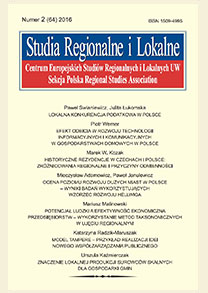Ocena poziomu rozwoju dużych miast w Polsce – wyniki badań wykorzystujących wzorzec rozwoju Hellwiga
Evaluation of socio-economic development of large cities in Poland – results of a study with the use of the Hellwig development pattern method
Author(s): Mieczysław Adamowicz, Paweł JanulewiczSubject(s): Social Sciences, Economy, Geography, Regional studies, Sociology, Rural and urban sociology
Published by: EUROREG - Uniwersytet Warszawski, Regional Studies Association - Sekcja Polska
Keywords: cities in Poland; local development; Hellwig development pattern method
Summary/Abstract: The aim of the paper is to define and evaluate the level of local socio-economic development of largest cities in Poland, as well as the differences and disproportions which appeared between them in the years 2010-2012. The subject of the research were 30 cities in Poland whose population exceeded 120 thousand. These cities fulfil key roles in the country. A literature review and an empirical analysis were used as the base for this work. The data from the Local Data Bank (by CSO) were analyzed with the use of one of the taxonomic methods – the Hellwig development pattern method. Originally, 67 diagnostic variables were examined which, after verification, were cut down to 42 variables. Five groups of variables were distinguished: demographic figures, quality and availability of cultural and educational services, labour and social security conditions, housing conditions, and economic potential. Statistical description of the cities was prepared for all the groups of variables. The differences and disproportions between the cities were revealed. After reduction, 21 variables were used. Four groups of cities representing different levels of local development were distinguished. The results of the research allow for a comparative assessment of each city with reference to its characteristics. The research results showed substantial differences and disproportions in the level of local socio-economic development of the surveyed cities. The used method proved to be an adequate tool for local development analysis. The synthetic measures and indexes proved to be a useful tool of city management.
Journal: Studia Regionalne i Lokalne
- Issue Year: 17/2016
- Issue No: 64
- Page Range: 68-86
- Page Count: 19
- Language: English, Polish

